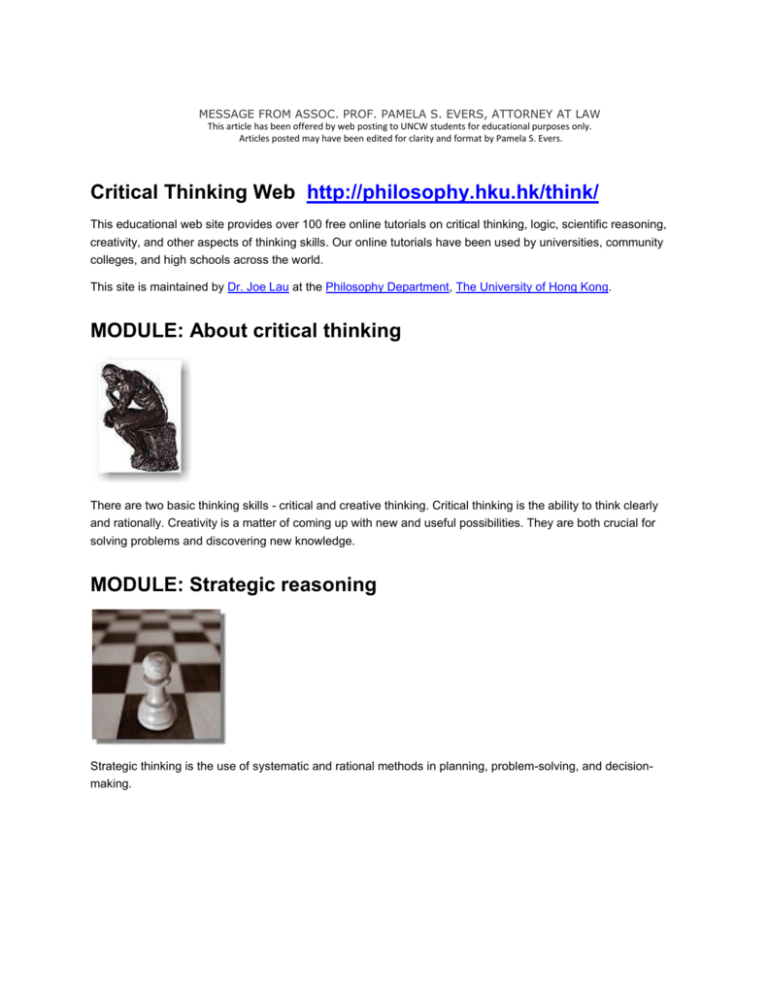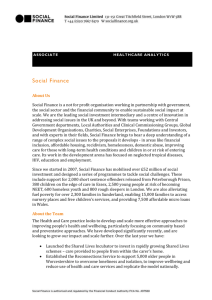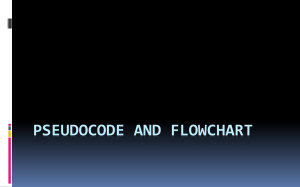Strategic Thinking.Critical Thinking Web
advertisement

MESSAGE FROM ASSOC. PROF. PAMELA S. EVERS, ATTORNEY AT LAW This article has been offered by web posting to UNCW students for educational purposes only. Articles posted may have been edited for clarity and format by Pamela S. Evers. Critical Thinking Web http://philosophy.hku.hk/think/ This educational web site provides over 100 free online tutorials on critical thinking, logic, scientific reasoning, creativity, and other aspects of thinking skills. Our online tutorials have been used by universities, community colleges, and high schools across the world. This site is maintained by Dr. Joe Lau at the Philosophy Department, The University of Hong Kong. MODULE: About critical thinking There are two basic thinking skills - critical and creative thinking. Critical thinking is the ability to think clearly and rationally. Creativity is a matter of coming up with new and useful possibilities. They are both crucial for solving problems and discovering new knowledge. MODULE: Strategic reasoning Strategic thinking is the use of systematic and rational methods in planning, problem-solving, and decisionmaking. TUTORIAL G01: How to classify problems Solving problems require good critical and creative thinking. We need to be able to define the problem, analyse the nature of the problem, and come up with effective solutions. The ability to solve problems is a very important skill in the workplace. G01.1 Defining the problem When we are faced with a difficult problem, how should we go about solving it in an efficient and effective manner? An important starting point is knowing what the problem is. In school students are usually solving problems that are already well-formulated. Most problem sets and exam questions are like that. However, in everyday life and in the workplace, most of the time we have to identify the problem and formulate it correctly. In defining a problem there are these points to consider : The formulation of a problem can indirectly influence us in the directions that we take in seeking solutions. So sometimes it might be useful to come up with alternative formulations of the problem, and consider how to best formulate a problem. For example, faced with an unhappy relationship on the verge of breakup, one might think of the problem as "why is she leaving me?", and focus on the faults and reasons of the other person. But thinking of the problem in terms of "what have I been doing wrong" might lead one to focus more on oneself and think about what one might do to rescue the relationship. Similarly, instead of focusing on how a business competitor is taking away business from one's own company, the real problem to focus on might be why one's own company is not doing enough to adapt to the new market. If the problem concerns how a goal or target might be achieved, it is important to avoid vagueness and try to be more specific. If we are thinking about how to improve a company's profit, it would be useful to say more precisely how much of an increase we are looking for, in order to know whether the goal is realistic or not. It is also important to think about whether the problem so-defined is real or not. What data is available to show that there is a real problem to be solved? For example a university might be concerned that student standards are dropping. It would be useful to have information available confirming that this is not a subjective judgment but an actual declining trend. Gathering more data about the problem can also help us understand how serious it is and which are the most important factors to consider in dealing with it. G01.2 Problem classification Having defined the problem, the next thing to do is to know what type of problem it is. Generally, a problem might be posed in the form of a question, and we might classify these questions into three kinds : Empirical questions Conceptual questions Evaluative questions Empirical questions are questions concerning empirical facts, particular events or causal processes in the world. Here are some examples : Who is the current president of the United States? Did Germany participated in the First World War? Can AIDS be transmitted through kissing? Is the universe expanding? To answer an empirical question, we need observations or experiments, or solicit the help of experts in the relevant field, such as physics, biology, psychology, economics, history, etc. Very often these questions cannot be answered by sitting in the armchair. For example, consider the question of whether human beings evolved from other forms of animals. This is an empirical question to be answered by careful scientific study. We might have certain convictions or intuitions about the answer, and be inclined to believe one way or another. But these prior beliefs should be evaluated according to empirical data. Pure thinking is not going to help find the answer. On the other hand, pure thinking can help us answer conceptual questions. Here are some examples of conceptual questions : Is rule of law sufficient for democracy? Can a woman sexually harass a man? Are there any married bachelors? Is 981567 divisible by 3? To answer these questions, we appeal to logic and the meaning of words and concepts to arrive at the answers without engaging in experiments or observations. In other words, mere thinking is enough to answer these questions. Here, "mere thinking" refers to conceptual analysis and reasoning. For example, in answering the first question, we note that "rule of law" means the consistent use of due procedure and legal processes in a society where the legal principles are not arbitrarily applied or withheld. But we might note that the laws in a society where this is the case might nonetheless discriminate against certain social groups and provide them with inadequate political representation in the government. As long as these rules are not abused and are consistently applied, there is rule of law but no democracy. Using pure reasoning and our understanding of the concepts of "rule of law" and "democracy", we conclude that rule of law is not sufficient for democracy. Similarly, the other conceptual questions are questions which can be answered without empirical observations or scientific study. Finally, let us consider evaluative questions. Evaluative questions are questions which explicitly or implicitly invoke values and norms. These questions relate to value judgments about moral correctness or aesthetic values. Here are some examples : Is abortion immoral? Is Beethoven a more profound composer than Mozart? Should the amount of unemployment benefits be raised? To answer this type of questions, we need to understand the distinction between intrinsic and instrumental values. Very briefly, intrinsic value is value that exists on its own. The intrinsic value of an object does not depend on its being used to satisfy some further end. But if something has value only because and in so far as it can be used to satisfy a further end, and would cease to have value if it fails to do so, then the value involved is instrumental value. (See here for further discussion.) So here is a summary : G01.3 Mixed questions Conceptual questions might be regarded as the most basic kind of question among the three categories. This is because factual and evaluative questions can only be answered if we understand the relevant concepts invoked by the questions. For example, if we do not know what a black hole is, we cannot answer the question "Can light escape from a black hole?" Similarly, we need to know what abortion is if we want to find out whether abortion is immoral. Empirical questions are generally independent of evaluative questions. We do not have to consider any evaluative judgements if we want to answer an empirical question. However, the reverse is not true. To answer many evaluative questions, we need to know quite a few empirical facts. For example, to evaluate whether an action is morally right or wrong, we usually have to consider the consequences of the action, or the motives behind the action. Once we know these empirical facts, we can then apply the correct moral standards to judge whether the action is good or bad. Suppose we want to find out whether it was right for the US to drop two atomic bombs onto Japan. We have to consider empirical facts such as Japanese atrocities during the Second World War, the extent of the destruction caused by the atomic bombs, the number of innocent civilians killed as a result, and whether there are other alternative ways of ending the war. These are all empirical matters which are important to consider in answering the questions. Many disputes and controversies persist because of bad thinking, and bad thinking techniques might take the form of failure to understand the nature and type of the questions that have to be answered. The distinction between three types of questions discussed here is a simple and crucial part of the methodology in problemsolving. TUTORIAL G02: Problem solving procedures Polya's 1971 book How to solve it is a classic text on problem solving. According to Polya, most problemsolving strategies can be classified under four general principles: Understand the nature of the problem Draw up a plan to solve the problem. Try out the plan. Monitor the outcome of the plan. Let us highlight some important points to consider when we have to apply these four principles: 1. Understand the nature of the problem Is the problem well-defined? Can the problem be analysed into smaller sub-problems? What type of problem is it? (See the last tutorial on classifying problems.) What information can we gather about the problem? Have I / other people solve this problem before? What lessons might their experiences offer? What are the constraints (time, money, resources, etc) in solving the problem? 2. Draw up a plan Determine the time and resources needed. Carry out necessary preparations, e.g. research, coordination, etc. For solving problems that require a complex plan, write down the plan in a systematic manner. 3. Try out the plan Monitor progress to make sure that things go according to plan. Record errors or special considerations for future review. 4. Monitor the outcome of the plan This is the part of problem-solving that most people tend to ignore. One way for us to improve is to review past experiences and understand why we succeed or fail. So it is important to monitor our own performance review the whole exercise in order that we can do even better in the future. TUTORIAL G03: Complex systems and processes Many problems involve complex systems or processes. We might be asked to explain how they work, or perhaps acquire a better understanding of them so that we know how they can be improved. In this module we discuss analytical methods that help us understanding complex systems and processes. The basic and simple idea behind is simply to understand the function and behavior of a complex object in terms of its components and their interaction. G03.1 Analysing a complex input-output process In the commercial or industiral environment, process analysis is a basic part of quality management and strategic development. Here, a process is seen as a procedure composing of many steps which convert one or more inputs into one or more outputs. In a factory production line, the inputs might be raw materials or electronic components, and the output might be a particular product such as a computer. To carry out a process analysis, we identify the different parts of the process, and draw a diagram showing how one part of the process leads to another part of the process. To begin the analysis, we might divide the whole process into its major parts, and then we can carry out further analysis on the larger parts and show how they are composed for different activities and tasks. This process of decomposition allows us to see how the process is organized : One way to draw a systematic diagram of a complex process is to use flowcharts. You can refer to these notes to find out more about flowcharts. G03.2 Analysing a complex system The same decomposition method can be used in understanding a complex system. For example, a computer is composed of different part, including memory, processor, display, and interface components such as keyboard and mouse. To understand how a computer works, we identify the functions of different components, and see how they interact with each other. TUTORIAL G04: Using charts and diagrams Charts and diagrams play an extremely important role in displaying information and assisting reasoning. They help us visualize complex processes, or make explicit the structure of problems and tasks. On this page we introduce some common visual tools. Flowcharts Decision trees Cause and effect diagrams It is hard to describe systematically the art of using diagrams to present relevant information accurately and succintly. But here are a few simple reminders on interpreting and presenting charts containing statistical information: Misleading diagrams G04.1 Flowcharts A flowchart is a diagram constructed from connected shapes representing a process or a plan. Here is an example of a simple flowchart illustrating the process of going to school. Flowcharts have two main functions. First, a flowchart can be used to analyse a complex process, by breaking down the process into individual steps or components. The diagram can then be used : as a basis for further discussion of the process to identify points where data can be collected and analysed to identify bottlenecks and inefficiencies to explain the process to other people A flowchart can also be used to define a process or project to be implemented. Such a diagram is useful because : it spells out clearly the steps that have to be implemented it provides the basis for identifying potential problems responsibilities for different parts of the process can be clearly defined The modern flowchart originated in computer science as a tool for representing algorithms and computer programs, but the use of flowcharts has extended to the representation of all other kinds of processes. Notation In a standard flowchart, different shapes have different conventional meanings. The meanings of some of the more common shapes are as follows: The terminator symbol represents the starting or ending point of the system. A box indicates some particular operation. This represents a printout, such as a document or a report. A diamond represents a decision or branching point. Lines coming out from the diamond indicates different possible situations, leading to different sub-processes. It represents material or information entering or leaving the system. An input might be an order from a customer. An output can be a product to be delievered. This symbol would contain a letter inside. It indicates that the flow continues on a matching symbol containing the same letter somewhere else on the same page. As above, except that the flow continues at the matching symbol on a different page. Identifies a delay or a bottleneck. Lines represent the sequence and direction of a process. For further information about standard notation, please refer to : International Organisation for Standardisation (ISO), ISO 5807 Information processing -Documentation symbols and conventions; program and system flowcharts. American National Standard, ANSI X3.6-1970, Flowchart Symbols and their Usage in Information Processing. Deployment flowcharts One type of flowchart which is quite useful in project planning is deployment flowchart. A deployment flowchart is just a flowchart drawn inside a table with different columns, e.g. The table is divided into columns representing the parties responsible for implementing the process. Different parts of the process are placed in the column for which the relevant party is in charge. The diagram reveals clearly how responsibilities for the sub-processes are distributed. Hints for drawing flowcharts Write down the title of the flowchart. Identify the process that is shown. Make sure that the starting and ending points of the process can be easily located. Avoid crossing flow-lines if possible. Use informative labels in your diagram. The amount of details in a flowchart depends on the level of analysis required. Analysing flowcharts In a management context the following considerations should be taken into account in reviewing a flowchart: Where are the labor intensive processes? Where would possible delays and hiccups most likely occur? Are there places particularly suited for quality control? Are there duplicated or redundant processes? Is it possible to streamline any process or reduce the number of operations? Has any process been omitted? G04.2 Decision trees A decision tree diagram is a diagram that represents the possible consequences of a series of decisions in some situation. Here is a simple example : More sophisticated decision tree diagrams can represent the probabilities of different possible outcomes. Special methods can then be employed to calculate the overall probabilities of possible final outcomes, to help estimate risks and assist decision making. A decision tree diagram functions not just as a map for making decisions. It is also very useful in laying out the different positions on some complicated theoretical issue. Depending on how one might answer certain crucial questions, a decision tree diagram can help the user identify the theoretical consequences of the assumptions that he or she accepts. For example, here we have a very simple tree diagram on the topic of consciousness. G04.3 Cause and effect diagrams There are two main types of cause and effect diagrams - Bayesian causal nets, and fishbone diagrams. Bayesian causal nets are rather similar to decision tree diagrams. TUTORIAL G05: Decision theory G05.1 Introduction Decision theory might be considerd to be a branch of mathematics. It provides a more precise and systematic study of the formal or abstract properties of decision-making scenarios. Game theory concerns situations where the decisions of more than two parties are involved. Decision theory considers only the decisions of a single individual. Here we discuss only some very basic aspects of decision theory. The decision situations we consider are cases where a decision maker has to choose between a list of mutually exclusive decisions. In other words, from among the alternatives, one and only one choice can be made. Each of these choices might have one or more possible consequences that are beyond the control of the decision maker, which again are mutually exclusive. Consider an artificial example where someone, say Linda, is thinking of investing in the stock market. Suppose she is considering four alternatives : investing $8000, investing $4000, investing $2000, or not investing at all. These are the four choices that are within her control. The consequences of her investment, in terms of her profit or loses, are dependent on the market and beyond her control. We might draw up a payoff table as follows : Choices Profit Strong market Fair market Poor market invest $8000 $800 $200 -$400 invest $4000 $400 $100 -$200 invest $2000 $200 $50 -$100 invest $1000 $100 $25 -$50 Although the possible returns of the investment are beyond the control of the decision maker, the decision maker might or might not be able or willing to assign probabilities to them. If no probabilities are assigned to the possible consequences, then the decision situation is called "decision under uncertainty". If probabilities are assigned then the situation is called "decision under risk". This is a basic distinction in decision theory, and different analyses are in order. G05.2 Decision under uncertainty Maximin The Maximin decision rule is used by a pessimistic decision maker who wants to make a conservative decision. Basically, the decision rule is to consider the worst consequence of each possible course of action and chooses the one thast has the least worst consequence. Applying this rule to the payoff table above, the maximin rule implies that Linda should choose the last course of action, namely not to invest anything. Choices Profit Strong market Fair market Poor market invest $8000 $800 $200 -$400 invest $4000 $400 $100 -$200 invest $2000 $200 $50 -$100 invest $1000 $100 $25 -$50 Maximin tells Linda to consider the worst possible consequence of her possible choices. These are indicated by the orange boxes here. Among the worst consequences of the four choices, the last one is the best of the worst. So that would be choice to make. Maximax Choices Profit Strong market Fair market Poor market invest $8000 $800 $200 -$400 invest $4000 $400 $100 -$200 invest $2000 $200 $50 -$100 invest $1000 $100 $25 -$50 Whereas minimax is the rule for the pessimist, maximax is the rule for the optimist. A slogan for maximax might be "best of the best" - a decision maker considers the best possible outcome for each course of action, and chooses the course of action that corresponds to the best of the best possible outcomes. So in Linda's case if she employs this rule she would look at the first column and picks the fist course of action and invest $8000 since it gives her the largest possible return. Minimax regret This rule is for minimizing regrets. Regret here is understood as proportional to the difference between what we actually get, and the better position that we could have got if a different course of action had been chosen. Regret is sometimes also called "opportunity loss". Choices Regret Strong market Fair market Poor market invest $8000 0 0 350 invest $4000 400 100 150 invest $2000 600 150 50 invest $1000 700 175 0 In applying this decision rule, we list the maximum amount of regret for each possible course of action, and select the course of action that corresponds to the minimum of the list. In the example we have been considering, the maximum regret for each course of action is coloured orange, and the minimum of all the selected values is 350. So applying the minimax regret rule Linda should invest $8000. G05.3 Decision Making Under Risk When we are dealing with a decision where the possible outcomes are given specific probabilities, we say that this a case of decision making under risk. In such situations the principle of expected value is used. We calculate the expected value associated with each possible course of action, and select the course of action that has the higest expected value. To calculate the expected value for a course of action, we multiple each possible payoff associated with that course of action with its probability, and sum up all the products for that course of action. Choices Profit expected value Strong market (probability = 0.1) Fair market (probability = 0.5) Poor market (probability = 0.4) invest $8000 $800 $200 -$400 $800x0.1+$200x0.5+($400)x0.4=$20 invest $4000 $400 $100 -$200 $400x0.1+$100x0.5+($200)x0.4=$10 invest $2000 $200 $50 -$100 $200x0.1+$50x0.5+($100)x0.4=$5 invest $1000 $100 $25 -$50 $100x0.1+$25x0.5+($50)x0.4=$2.5 Since the first course of action has the highest expected value, the principle of utility implies that Linda should invest $8000.







